abstract
This work aimed to investigate in vitro the influence of monoolein (MO) on progesterone (PG) transdermal delivery and skin retention. Information about the role of MO as an absorption enhancer for lipophilic molecules can help on innovative product development capable of delivering the hormone through the skin in a consistent manner, improving transdermal therapy of hormonal replacement. MO was dispersed in propylene glycol under heat at concentrations of 0% (control), 5% w/w, 10% w/w and 20% w/w. Then, 0.6% of PG (w/w) was added to each formulation. Permeation profile of the hormone was determined in vitro for 48 h using porcine skin in Franz diffusion cells. PG permeation doubled when 5% (w/w) of MO was present in formulation in comparison to both the control and higher MO concentrations (10% and 20% w/w). An equal trend was observed for PG retention in stratum corneum (SC) and reminiscent skin (E+D). PG release rates from the MO formulations, investigated using cellulose membranes, revealed that concentrations of MO higher than 5% (w/w) hindered PG release, which indeed negatively reflected on the hormone permeation through the skin. In conclusion, this work demonstrated the feasibility of MO addition (at 5% w/w) in formulations as a simple method to increase transdermal PG delivery for therapies of hormonal replacement. In contrast, higher MO concentrations (from 10% to 20% w/w) can control active release, and this approach could be extrapolated to other lipophilic, low-molecular-weight molecules.
Uniterms:
Monoolein/influence/transdermal therapy; Progesterone/transdermal delivery; Progesterone/skin retention; Hormonal replacement/transdermal therapy; Skin permeation.

 Thumbnail
Thumbnail
 Thumbnail
Thumbnail
 Thumbnail
Thumbnail
 Thumbnail
Thumbnail
 Thumbnail
Thumbnail




